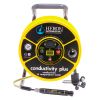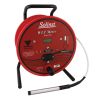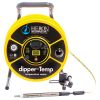Solinst Model 107 TLC Meters
Features
- Accuracy is to the greater of 100 uS or 5% of reading
- LCD simultaneously displays temperature & conductivity
- Built with rugged Solinst reel and accurate flat-tape marked every 1/100' or each mm
- Free ground shipping
- Expedited repair and warranty service
- Lifetime technical support
- More
Overview
The Solinst TLC Meter is ideal for profiling conductivity and temperature in wells and open water. It displays accurate measurements of conductivity and temperature on a convenient LCD display. Conductivity measurements are read from 0-80,000 uS/cm with readings giving accuracy of 5% of reading or 100 uS (whichever is greater). Water level and probe depth measurements are read off the Solinst durable PVDF flat tape, which is accurately laser marked every 1/100 ft or each millimeter. Tape lengths are now available up to 1000 ft (300m).
Design
The high quality PVDF flat tape reels smoothly, remains flexible and hangs straight in the well, irrespective of temperature. The flat tape is mounted on a sturdy, well-balanced Solinst reel, with a convenient battery drawer for the 9 Volt alkaline battery. Permanent laser markings each 1/100 ft or millimeter allow accurate readings. Stranded stainless steel conductors and copper coated stainless steel conductors resist corrosion, provide strength and are non-stretch. They make the tape easy to repair and splice. The dog-bone design reduces adherence to wet surfaces.
Mechanics
The Solinst TLC Meter uses a ‘smart’ conductivity sensor with platinum electrodes to measure conductivity. The conductivity is displayed on the screen along with the associated temperature measurement. The ‘smart probe’ displays conductivity that has been standardized to 25 C, i.e. Specific Conductance (displayed as EC). The conductance temperature coefficient is 2.0% per C. Calibration is simple, using 1413 uS, 5000 uS, 12,880 uS, and/or 80,000 uS solutions for 1, 2, 3, or 4 point manual conductivity calibrations.
- (1) Model 107 TLC meter
- (1) Tape guide/datum
In The News
Monitoring Habitat Suitability and Water Quality in Northwest Arkansas Springs
Northwest Arkansas has seen an economic, industrial, and population boom in recent years as a result of expanding businesses, which have created thousands of jobs in the region and the mass migration of employees and construction companies. However, with this growth has come rapid urbanization and the degradation of the natural landscape, specifically the freshwater springs that can be found throughout the region. These springs are critical habitat centers for native wildlife, home to threatened and endangered fish, and those that have yet to be listed. Zach Moran, Assistant Professor of Fisheries Science at Arkansas Technical University, is working to help monitor these habitats and provide key data that will hopefully inform future development in the region.
Read MoreThree Decades of Research at Acton Lake
A multi-disciplinary team at Miami University, Ohio, has been studying the environmental change at Acton Lake for over three decades. Using three different NexSens buoys over this time, the team has an incredible archive of data that is helping build a picture of Acton’s past, present, and future. Until recently, a NexSens CB-50 buoy was used alongside other environmental monitoring at Acton Lake. In May 2025, the Miami team deployed a new XB-200 buoy , future-proofing their ongoing monitoring using real-time buoy systems. Acton Lake, a small hypereutrophic reservoir in southwest Ohio, covers 2.4km² and has a maximum depth of about 8m. The dam was built in 1956, and the lake has a large agricultural watershed.
Read MoreSource Water Monitoring in Albany, New York: Tracing Water Quality throughout Tributaries
Thousands of US cities pull their drinking water from natural source waters like reservoirs, rivers, and streams, making overall watershed health a key consideration for water providers. In Albany, New York, the Albany Department of Water and Water Supply delivers drinking water to over 100,000 residents as well as monitors and manages the larger drinking water supply watershed. Hannah Doherty, Environmental Specialist at the Albany Department of Water and Water Supply , spends her days working with a small team to monitor the drinking supply and the connected water bodies. Doherty explains, “We’re the first to encounter the water that ends up being the drinking water.
Read More































